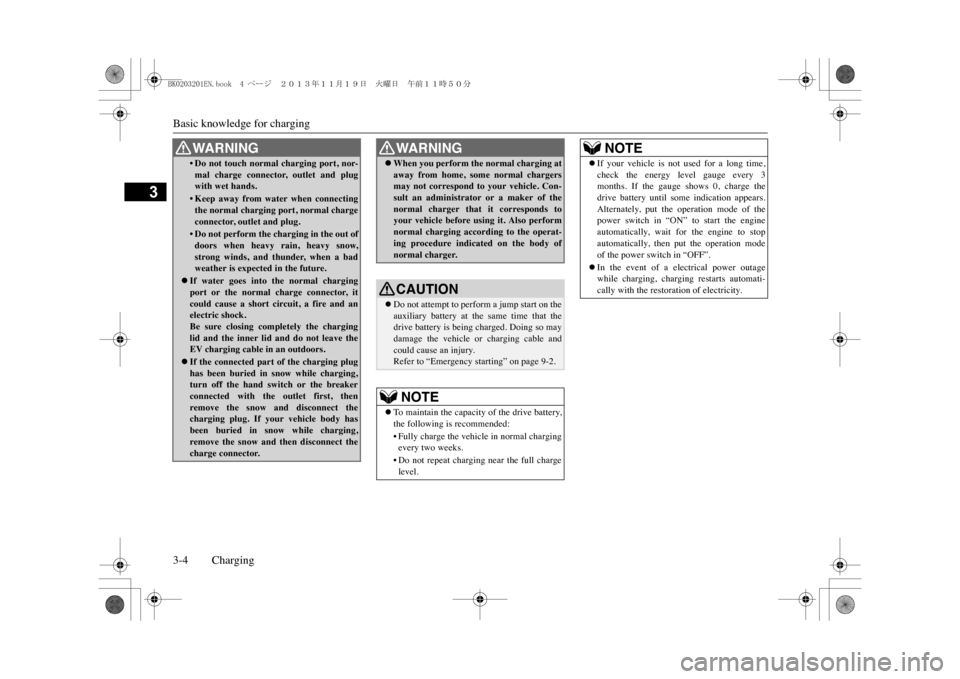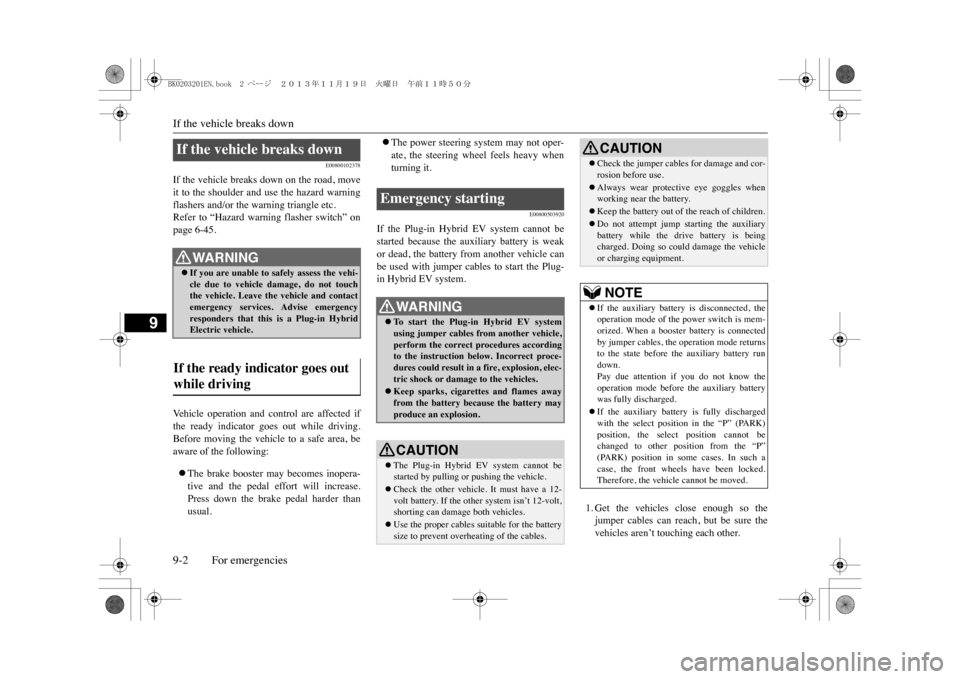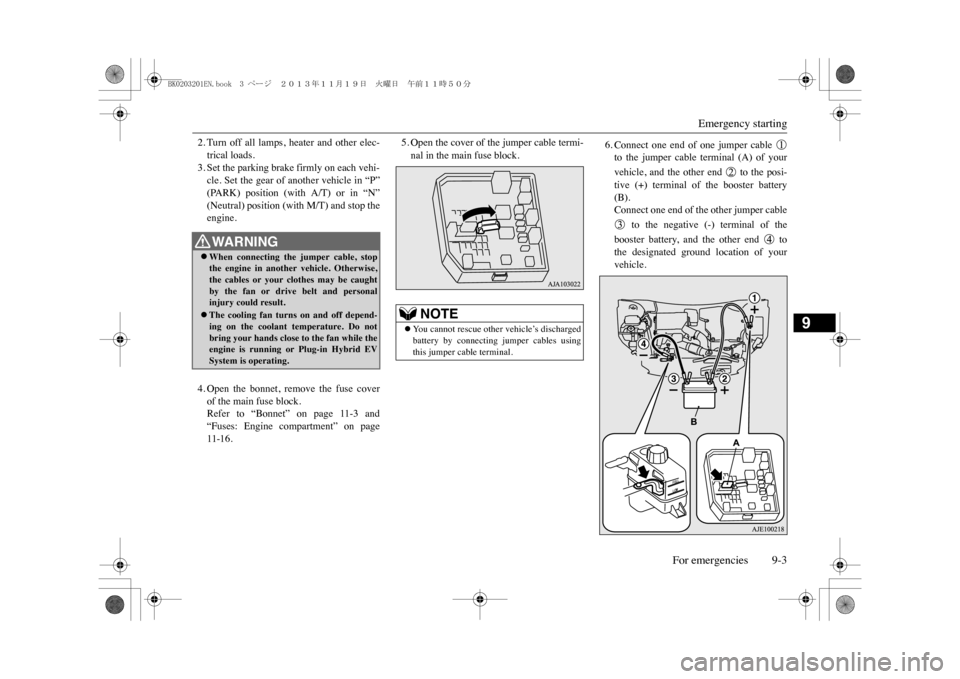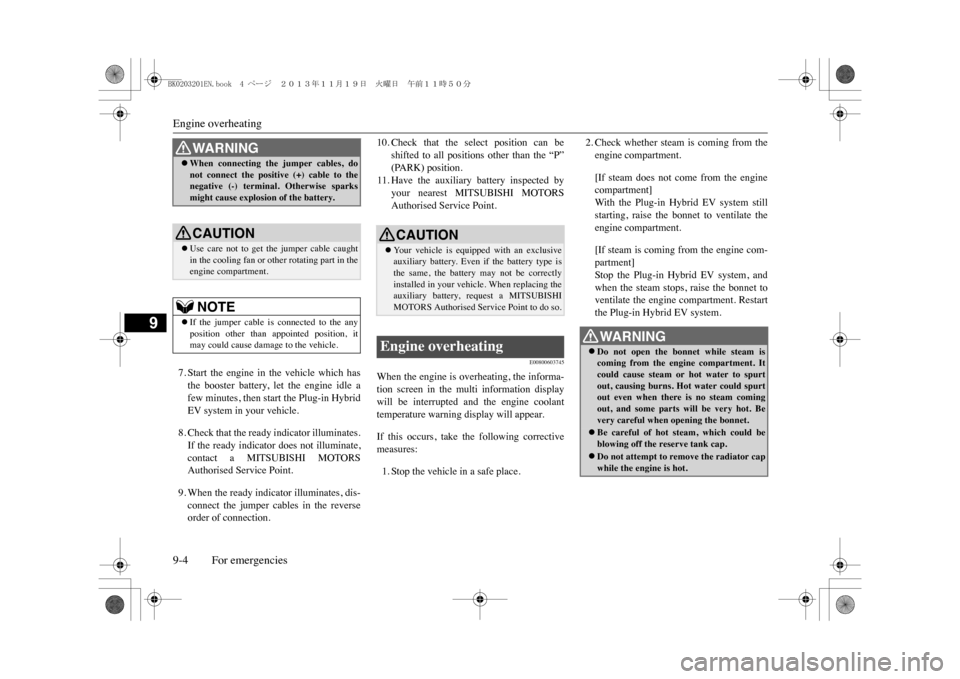2014 MITSUBISHI OUTLANDER SPORT jump cable
[x] Cancel search: jump cablePage 29 of 388

Basic knowledge for charging3-4 Charging
3
•Do not touch normal charging port, nor-mal charge connector, outlet and plugwith wet hands.•Keep away from water when connectingthe normal charging port, normal chargeconnector, outlet and plug.•Do not perform the ch
arging in the out of
doors when heavy rain, heavy snow,strong winds, and thunder, when a badweather is expected in the future.
�zIf water goes into the normal chargingport or the normal charge connector, itcould cause a short ci
rcuit, a fire and an
electric shock. Be sure closing completely the charginglid and the inner lid and do not leave theEV charging cable
in an outdoors.
�zIf the connected part of the charging plughas been buried in snow while charging,turn off the hand switch or the breakerconnected with the outlet first, thenremove the snow and disconnect thecharging plug. If your vehicle body hasbeen buried in snow while charging,remove the snow and then disconnect thecharge connector.WA R N I N G
�zWhen you perform the normal charging ataway from home, some normal chargersmay not correspond to your vehicle. Con-sult an administrator or a maker of thenormal charger that it corresponds toyour vehicle before using it. Also performnormal charging according to the operat-ing procedure indicated on the body ofnormal charger.CAUTION�zDo not attempt to perform a jump start on theauxiliary battery at the same time that thedrive battery is being charged. Doing so maydamage the vehicle or charging cable andcould cause an injury.Refer to “Emergency starting” on page 9-2.NOTE
�zTo m a i n t a i n t h e c a p a c i t y o f t h e d ri v e b a t t e r y,the following is recommended:•Fully charge the vehicle in normal chargingevery two weeks.• Do not repeat charging near the full chargelevel.WA R N I N G
�zIf your vehicle is not used for a long time,check the energy level gauge every 3months. If the gauge shows 0, charge thedrive battery until some indication appears.Alternately, put the operation mode of thepower switch in “ON” to start the engineautomatically, wait for the engine to stopautomatically, then put the operation modeof the power switch in “OFF”.�zIn the event of a electrical power outagewhile charging, charging restarts automati-cally with the restoration of electricity.NOTE
BK0203201EN.book 4 ページ 2013年11月19日 火曜日 午前11時50分
Page 313 of 388

If the vehicle breaks down9-2 For emergencies
9
E00800102378
If the vehicle breaks down on the road, moveit to the shoulder and use the hazard warningflashers and/or the warning triangle etc.Refer to “Hazard warning flasher switch” onpage 6-45.Ve h i c l e o p e r a t i o n a n d c o n t r o l a r e a f f e c t e d i fthe ready indicator goes out while driving.Before moving the vehicle to a safe area, beaware of the following:�zThe brake booster may becomes inopera-tive and the pedal effort will increase.Press down the brake pedal harder thanusual.
�zThe power steering system may not oper-ate, the steering wheel feels heavy whenturning it.
E00800503920
If the Plug-in Hybrid EV system cannot bestarted because the auxiliary battery is weakor dead, the battery from another vehicle canbe used with jumper cables to start the Plug-in Hybrid EV system.
1. Get the vehicles close enough so thejumper cables can reach, but be sure thevehicles aren’t touching each other.
If the vehicle breaks down
WA R N I N G�zIf you are unable to safely assess the vehi-cle due to vehicle damage, do not touchthe vehicle. Leave the vehicle and contactemergency services. Advise emergencyresponders that this is a Plug-in HybridElectric vehicle.
If the ready indicator goes out while driving
Emergency starting
WA R N I N G�zTo s t a r t t h e P l u g - i n H y b r i d E V s y s t e musing jumper cables from another vehicle,perform the correct procedures accordingto the instruction below. Incorrect proce-dures could result in a fire, explosion, elec-tric shock or damage
to the vehicles.
�zKeep sparks, cigarettes and flames awayfrom the battery because the battery mayproduce an explosion.CAUTION�zThe Plug-in Hybrid EV system cannot bestarted by pulling or pushing the vehicle.�zCheck the other vehicle.
It must have a 12-
volt battery. If the other system isn’t 12-volt,shorting can damage
both vehicles.
�zUse the proper cables suitable for the batterysize to prevent overhea
ting of the cables.
�zCheck the jumper cables for damage and cor-rosion before use.�zAlways wear protect
ive eye goggles when
working near the battery.�zKeep the battery out of the reach of children.�zDo not attempt jump starting the auxiliarybattery while the drive battery is beingcharged. Doing so could damage the vehicleor charging equipment.NOTE
�zIf the auxiliary battery is disconnected, theoperation mode of the power switch is mem-orized. When a booster
battery is connected
by jumper cables, the operation mode returnsto the state before the auxiliary battery rundown.Pay due attention if you do not know theoperation mode before
the auxiliary battery
was fully discharged.�zIf the auxiliary battery is fully dischargedwith the select position in the “P” (PARK)position, the select position cannot bechanged to other position from the “P”(PARK) position in some cases. In such acase, the front wheels have been locked.Therefore, the vehicle cannot be moved.CAUTION
BK0203201EN.book 2 ページ 2013年11月19日 火曜日 午前11時50分
Page 314 of 388

Emergency starting
For emergencies 9-3
9
2. Turn off all lamps, heater and other elec-trical loads.3. Set the parking brake firmly on each vehi-cle. Set the gear of another vehicle in “P”(PARK) position (with A/T) or in “N”(Neutral) position (with M/T) and stop theengine.4. Open the bonnet, remove the fuse coverof the main fuse block.Refer to “Bonnet” on page 11-3 and“Fuses: Engine compartment” on page11-16.
5. Open the cover of the jumper cable termi-nal in the main fuse block.
6. Connect one end of one jumper cable to the jumper cable terminal (A) of yourvehicle, and the other end to the posi-tive (+) terminal of the booster battery(B).Connect one end of the other jumper cable to the negative (-) terminal of thebooster battery, and the other end tothe designated ground location of yourvehicle.
WA R N I N G�zWhen connecting the jumper cable, stopthe engine in another vehicle. Otherwise,the cables or your cl
othes may be caught
by the fan or drive belt and personalinjury could result.�zThe cooling fan turns on and off depend-ing on the coolant temperature. Do notbring your hands close to the fan while theengine is running or Plug-in Hybrid EVSystem is operating.
NOTE
�zYo u c a n n o t r e s c u e o t h e
r vehicle’s discharged
battery by connecting jumper cables usingthis jumper cable terminal.
BK0203201EN.book 3 ページ 2013年11月19日 火曜日 午前11時50分
Page 315 of 388

Engine overheating9-4 For emergencies
9
7. Start the engine in the vehicle which hasthe booster battery, let the engine idle afew minutes, then start the Plug-in HybridEV system in your vehicle.8. Check that the ready indicator illuminates.If the ready indicator does not illuminate,contact a MITSUBISHI MOTORSAuthorised Service Point.9. When the ready indicator illuminates, dis-connect the jumper cables in the reverseorder of connection.
10. Check that the select position can be
shifted to all positions other than the “P”(PARK) position.
11. Have the auxiliary battery inspected by
your nearest MITSUBISHI MOTORSAuthorised Service Point.
E00800603745
When the engine is overheating, the informa-tion screen in the multi information displaywill be interrupted and the engine coolanttemperature warning display will appear.If this occurs, take the following correctivemeasures:1. Stop the vehicle in a safe place.
2. Check whether steam is coming from theengine compartment.[If steam does not come from the enginecompartment]Wi t h t h e Pl ug - i n H yb r i d E V s ys t em s t i l lstarting, raise the bonnet to ventilate theengine compartment.[If steam is coming from the engine com-partment]Stop the Plug-in Hybrid EV system, andwhen the steam stops, raise the bonnet toventilate the engine compartment. Restartthe Plug-in Hybrid EV system.
WA R N I N G�zWhen connecting the jumper cables, donot connect the positive (+) cable to thenegative (-) terminal. Otherwise sparksmight cause explosion of the battery.CAUTION�zUse care not to get the jumper cable caughtin the cooling fan or other rotating part in theengine compartment.NOTE
�zIf the jumper cable is
connected to the any
position other than a
ppointed position, it
may could cause damage to the vehicle.
CAUTION�zYo u r v e h i c l e i s e q u i p p e d w i t h a n e x c l u s i v eauxiliary battery. Even if the battery type isthe same, the battery may not be correctlyinstalled in your vehicle. When replacing theauxiliary battery, request a MITSUBISHIMOTORS Authorised Service Point to do so.
Engine overheating
WA R N I N G�zDo not open the bonnet while steam iscoming from the engine compartment. Itcould cause steam or hot water to spurtout, causing burns. Hot water could spurtout even when there is no steam comingout, and some parts will be very hot. Bevery careful when opening the bonnet.�zBe careful of hot steam, which could beblowing off the reserve tank cap.�zDo not attempt to remove the radiator capwhile the engine is hot.
BK0203201EN.book 4 ページ 2013年11月19日 火曜日 午前11時50分